Glacier Recession and Climate Change in Chitral, Eastern Hindu Kush Mountains of Pakistan, Between 1992 and 2022
Abstract
:1. Introduction
2. Study Area
3. Methods
3.1. Glacier Mapping
3.2. Climate Data Analysis
3.2.1. Long-Term Temperature and Precipitation Trends
3.2.2. Magnitude and Direction of Temperature and Precipitation Trends
3.2.3. Monthly Temperature and Precipitation Trends
3.3. Land Surface Temperature
4. Results
4.1. Changes in Glacier Area
4.2. Changes in Temperature
4.3. Changes in Precipitation
5. Illegal Ice and Snow Harvesting
6. Discussion
7. Conclusions
Author Contributions
Funding
Data Availability Statement
Conflicts of Interest
References
- Hori, M.; Sugiura, K.; Kobayashi, K. A 38-year (1978–2015) Northern Hemisphere daily snow cover extent product derived using consistent objective criteria from satellite-borne optical sensors. Remote Sens. Environ. 2017, 191, 402–418. [Google Scholar] [CrossRef]
- Rowan, A.V.; Quincey, D.J.; Gibson, M.J.; Glasser, N.F.; Westoby, M.J.; Irvine-Fynn, T.D.L.; Porter, P.R.; Hambrey, M.J. The sustainability of water resources in High Mountain Asia in the context of recent and future glacier change. Geol. Soc. Spec. Publ. 2018, 462, 189–204. [Google Scholar] [CrossRef]
- Hussain, A.; Sagin, J.; Bekbayeva, A.; Abid, M. Climate change and its impact on glaciers in Hindu Kush region: A case study of Yarkhun Valley, Chitral Pakistan. In Proceedings of the 40th Asian Conference on Remote Sensing (ACRS 2019): Progress of Remote Sensing Technology for Smart Future, Daejeon, Republic of Korea, 14–18 October 2019; pp. 3007–3018. [Google Scholar]
- Sahu, R.; Gupta, R.D. Snow cover area analysis and its relation with climate variability in Chandra basin, Western Himalaya, during 2001–2017 using MODIS and ERA5 data. Environ. Monit. Assess. 2020, 192, 489. [Google Scholar] [CrossRef] [PubMed]
- Viviroli, D.; Kummu, M.; Meybeck, M.; Kallio, M.; Wada, Y. Increasing dependence of lowland populations on mountain water resources. Nat. Sustain. 2020, 3, 917–928. [Google Scholar] [CrossRef]
- Wang, X.; Liu, S.W.; Zhang, J.L. A new look at roles of the cryosphere in sustainable development. Adv. Clim. Change Res. 2019, 10, 124–131. [Google Scholar] [CrossRef]
- Terzi, S.; Torresan, S.; Schneiderbauer, S.; Critto, A.; Zebisch, M.; Marcomini, A. Multi-risk assessment in mountain regions: A review of modelling approaches for climate change adaptation. J. Environ. Manag. 2019, 232, 759–771. [Google Scholar] [CrossRef]
- Wester, P.; Mishra, A.; Mukherji, A.; Shrestha, A.B. (Eds.) The Hindu Kush Himalaya Assessment: Mountains, Climate Change, Sustainability and People; Springer Nature: Cham, Switzerland, 2019. [Google Scholar]
- Kraaijenbrink, P.D.A.; Bierkens, M.F.P.; Lutz, A.F.; Immerzeel, W.W. Impact of a global temperature rise of 1.5 degrees Celsius on Asia’s glaciers. Nature 2017, 549, 257–260. [Google Scholar] [CrossRef]
- Rangwala, I.; Miller, J.R. Climate change in mountains: A review of elevation-dependent warming and its possible causes. Clim. Change 2012, 114, 527–547. [Google Scholar] [CrossRef]
- Mountain Research Initiative EDW Working Group (MRI). Elevation-depending warming in mountain regions of the world. Nat. Clim. Change 2015, 5, 424–430. [Google Scholar] [CrossRef]
- Yasmeen, Z.; Afzaal, M. Application of remote sensing for temporal mapping of glacier and glacial lake. Pak. J. Meteorol. 2017, 13, 1–8. [Google Scholar]
- Tahir, A.A.; Hakeem, S.A.; Hu, T.; Hayat, H.; Yasir, M. Simulation of snowmelt-runoff under climate change scenarios in a data-scarce mountain environment. Int. J. Digit. Earth 2017, 12, 910–930. [Google Scholar] [CrossRef]
- Farhan, M.; Moazzam, U. Trend of snow cover under the influence of climate change using Google Earth Engine platform: A case study of Astore (Western Himalayas) and Shigar (Karakoram region). Front. Environ. Sci. 2022, 10, 1006399. [Google Scholar]
- Banerjee, A.; Chen, R.; Meadows, M.E.; Semgupta, D.; Pathak, S.; Zilong, X.; Mal, S. Tracking 21st century climate dynamics of the Third Pole: An analysis of topo-climate impacts on snow cover in the central Himalaya using Google Earth Engine. Int. J. Appl. Earth Obs. Geoinf. 2021, 103, 102490. [Google Scholar] [CrossRef]
- International Centre for Integrated Mountain Development (ICIMOD). ICIMOD at COP29, and at 41: Bolstering Our Climate Action for Mountains and Vulnerable Communities. 2024. Available online: https://www.icimod.org/icimod-at-cop29-and-at-41-bolstering-our-climate-action-for-mountains-and-vulnerable-communities/?utm_source=emailoctopus&utm_medium=email&utm_campaign=Newsletter (accessed on 14 February 2025).
- Rasul, G.; Mahmood, A.; Sadiq, A.; Khan, S.I. Vulnerability of the Indus delta to climate change in Pakistan. Pak. J. Meteorol. 2012, 8, 89–107. [Google Scholar]
- Krishnan, R.; Shrestha, A.R.; Ren, G.; Rajbhandari, R.; Saeed, S.; Sanjay, J.; Syed, M.A.; Vellore, R.; Xu, Y.; You, Q.; et al. Unravelling climate change in the Hindu Kush Himalaya: Rapid warming in the mountains and increasing extremes. In The Hindu Kush Himalaya Assessment: Mountains, Climate Change, Sustainability and People; Wester, P., Mishra, A., Mukherji, A., Shrestha, A.B., Eds.; Springer Nature: Cham, Switzerland, 2019; pp. 57–97. [Google Scholar]
- Bajracharya, S.R.; Maharjan, S.B.; Shrestha, F.; Guo, W.; Liu, S.; Immerzeel, W.; Shrestha, B. The glaciers of the Hindu Kush Himalayas: Current status and observed changes from the 1980s to 2010. Int. J. Water Resour. Dev. 2015, 31, 161–173. [Google Scholar] [CrossRef]
- Hewitt, K. The Karakoram anomaly? Glacier expansion and the “Elevation effect,” Karakoram Himalaya. Mt. Res. Dev. 2005, 25, 332–340. [Google Scholar] [CrossRef]
- Hewitt, K. Glacier change, concentration, and elevation effects in the Karakoram Himalaya, upper Indus basin. Mt. Res. Dev. 2011, 31, 188–200. [Google Scholar] [CrossRef]
- Miller, J.D.; Immerzeel, W.W.; Rees, G. Climate change impacts on glacier hydrology and river discharge in the Hindu Kush-Himalayas. Mt. Res. Dev. 2012, 32, 461–467. [Google Scholar] [CrossRef]
- Brun, F.; Berthier, E.; Wagnon, P.; Kääb, A.; Treichler, D. A spatially resolved estimate of High Mountain Asia glacier mass balances from 2000 to 2016. Nat. Geosci. 2017, 10, 668–673. [Google Scholar] [CrossRef]
- Sakai, A. Updated GAMDAM glacier inventory over high-mountain Asia. Cryosphere 2019, 13, 2043–2049. [Google Scholar] [CrossRef]
- Shean, D.E.; Bhushan, S.; Montesano, P.; Rounce, D.R.; Arendt, A.; Osmanoglu, B. A systematic, regional assessment of High Mountain Asia glacier mass balance. Front. Earth Sci. 2020, 7, 363. [Google Scholar] [CrossRef]
- Zekollari, H.; Huss, M.; Farinotti, D. On the imbalance and response time of glaciers in the European Alps. Geophys. Res. Lett. 2020, 47, e2019GL085578. [Google Scholar] [CrossRef]
- Eckstein, D.; Künzel, V.; Schäfer, L. (Eds.) Global Climate Risk Index 2018: Who Suffers Most from Extreme Weather Events? Weather-related Loss Events in 2016 and 1997 to 2016; Germanwatch: Bonn, Germany, 2018. [Google Scholar]
- Moazzam, M.F.U.; Rahman, G.; Ali, K.S.; Lee, B.G. Spatio-temporal snow cover change in the early twenty-first century using improved MODIS dataset: A case study of District Hunza, Pakistan. Clim. Dyn. 2023, 60, 3417–3433. [Google Scholar] [CrossRef]
- Rai, S.C.; Mukherjee, N.R. Spatio-temporal change delineation and forecasting of snow/ice-covered areas of Sikkim Himalaya using multispectral and thermal band combinations of Landsat imagery. Environ. Chall. 2021, 4, 100163. [Google Scholar] [CrossRef]
- Intergovernmental Panel on Climate Change (IPCC). The Ocean and Cryosphere in a Changing Climate; Cambridge University Press: Cambridge, UK, 2022. [Google Scholar]
- Carrivick, J.L.; Tweed, F.S. A review of glacier outburst floods in Iceland and Greenland with a megafloods perspective. Earth-Sci. Rev. 2019, 196, 102876. [Google Scholar] [CrossRef]
- Hayat, H.; Tahir, A.A.; Wajid, S.; Abbassi, A.M.; Zubair, F.; Hashmi, Z.R.; Khan, A.; Khan, A.J.; Irshad, M. Simulation of the meltwater under different climate change scenarios in a poorly gauged snow and glacier-fed Chitral River catchment (Hindukush region). Geocarto Int. 2022, 37, 103–119. [Google Scholar] [CrossRef]
- Rahman, F. Persistence and Transformation in the Eastern Hindu Kush: A Study of Resource Management Systems in Mehlp Valley, Chitral, North Pakistan; Bonner Geographische Abhandlungen 118: Bonn, Germany, 2007. [Google Scholar]
- Government of Pakistan. Seventh Population and Housing Census 2023; Pakistan Bureau of Statistics: Islamabad, Pakistan, 2023. [Google Scholar]
- Ahmad, Z. The Changing Pattern of Mountain Agriculture and Its Impact on Livelihood Strategies in the Eastern Hindu Kush: A Study of Lotkoh Valley, Chitral, North Pakistan. Ph.D. Thesis, University of Peshawar, Peshawar, Pakistan, 2021. [Google Scholar]
- Altaf, F. Impact of Climate Change on the Cryosphere: A Geospatial Assessment of Glaciers of the Eastern Hindu Kush, Chitral, Pakistan. Master’s Thesis, The Islamia University of Bahawalpur, Bahawalpur, Pakistan, 2023. [Google Scholar]
- Keshri, A.K.; Shukla, A.; Gupta, R.P. ASTER ratio indices for supraglacial terrain mapping. Int. J. Remote Sens. 2009, 30, 519–524. [Google Scholar] [CrossRef]
- Mann, H.B. Nonparametric tests against trend. Econometrica 1945, 13, 245–259. [Google Scholar] [CrossRef]
- Kendall, M.G.; Stuart, A. The advanced theory of statistics. Technometrics 1961, 5, 525–528. [Google Scholar]
- Yadav, R.; Tripathi, S.K.; Pranuthi, G.; Dubey, S.K. Trend analysis by Mann–Kendall test for precipitation and temperature for thirteen districts of Uttarakhand. J. Agrometeorol. 2014, 16, 164–171. [Google Scholar] [CrossRef]
- Kendall, M.G. Rank Correlation Measures; Charles Griffin: London, UK, 1975. [Google Scholar]
- Suryavanshi, S.; Panday, A.; Chaube, U.C.; Joshi, N. Long-term historic changes in climatic variables of Betla Basin, India. Theor. Appl. Climatol. 2014, 117, 403–418. [Google Scholar] [CrossRef]
- Frimpong, B.F.; Koranteng, A.; Molkenthin, F. Analysis of temperature variability utilizing Mann–Kendall and Sen’s slope estimator tests in the Accra and Kumasi metropolises in Ghana. Environ. Syst. Res. 2022, 11, 24. [Google Scholar] [CrossRef]
- Vinh, V.D.; Ouillon, S.; Hai, N.M. Sea surface temperature trend analysis by Mann-Kendall test and sen’s slope estimator: A study of the Hai Phong coastal area (Vietnam) for the period 1995-2020. Vietnam J. Earth Sci. 2022, 44, 73–91. [Google Scholar]
- Mamo, B.M.; Ndunda, E.; Muriuki, J. Temperature and rainfall trends analysis using Mann–Kendall and Sen’s slope estimator test in Marsabit County, Kenya. Int. J. Appl. Environ. Sci. 2024, 19, 107–127. [Google Scholar]
- Sen, P.K. Estimates of the regression coefficient based on Kendall’s tau. J. Am. Stat. Assoc. 1968, 63, 1379–1389. [Google Scholar] [CrossRef]
- Box, G.E.P.; Jenkins, G.M. Time Series Analysis, Forecasting and Control; Holden Day: San Francisco, CA, USA, 1970. [Google Scholar]
- Wilks, D.S. Statistical Methods in the Atmospheric Sciences; Academic Press: Burlington, UK, 2006. [Google Scholar]
- Hyndman, R.J.; Athanasopoulos, G. Forecasting: Principles and Practice; OTexts: Melbourne, Australia, 2018. [Google Scholar]
- Islam, M.; Zakaria, M.T. Forecasting of maximum and minimum temperature in the Cox’s Bazar Region of Bangladesh based on time series analysis. IOSR J. Math. 2019, 15, 56–67. [Google Scholar]
- Lai, Y.; Dzombak, D.A. Use of the autoregressive integrated moving average (ARIMA) model to forecast near-term regional temperature and precipitation. Weather Forecast. 2020, 35, 959–976. [Google Scholar] [CrossRef]
- Amjad, M.; Khan, A.; Fatima, K.; Ajazm, O.; Ali, S.; Main, M. Analysis of temperature variability, trends and prediction in the Karachi region of Pakistan using ARIMA models. Atmosphere 2023, 14, 88. [Google Scholar] [CrossRef]
- Diolaiuti, G.; Fugazza, D.; Gallo, M.; Melis, M.T. (Eds.) The New Inventory of 13,032 Glaciers in Pakistan: The “Glaciers and Students” Project; EvK2 CNR: Islamabad, Pakistan, 2024. [Google Scholar]
- Ashraf, A.; Roohi, R.; Naz, R.; Mustafa, N. Monitoring cryosphere and associated flood hazards in high mountain ranges of Pakistan using remote sensing technique. Nat. Hazards 2014, 73, 933–949. [Google Scholar] [CrossRef]
- Ashraf, A.; Batool, A. Evaluation of glacier resource potential for sustaining kuhl irrigation system under changing climate in the Himalayan region. J. Mt. Sci. 2019, 16, 1150–1159. [Google Scholar] [CrossRef]
- Gul, J.; Muhammad, S.; Liu, S.; Ullah, S.; Ahmad, S.; Hayat, H.; Tahir, A.A. Spatio-temporal changes in the six major glaciers of the Chitral River basin (Hindukush region of Pakistan) between 2001 and 2018. J. Mt. Sci. 2020, 17, 572–587. [Google Scholar] [CrossRef]
- Ahmad, S.; Israr, M.; Liu, S.; Hayat, H.; Gul, J.; Wajid, S.; Ashraf, M.; Baig, S.U.; Tahir, A.A. Spatio-temporal trends in snow extent and their linkage to hydro-climatological and topographical factors in the Chitral River Basin (Hindukush, Pakistan). Geocarto Int. 2018, 35, 711–734. [Google Scholar] [CrossRef]
- Burhan, A.; Usman, M.; Bukhari, S.A.A.; Sajjad, H. Contribution of glacier, snow and rain components in flow regime projected with HBV under AR5 based climate change scenarios over Chitral River Basin (Hindukush ranges, Pakistan). Int. J. Clim. Res. 2020, 4, 24–36. [Google Scholar]
- Syed, Z.; Ahmad, S.; Dahri, Z.H.; Azmat, M.; Shoaib, M.; Inam, A.; Qamar, M.U.; Hussain, S.Z.; Ahmad, S. Hydroclimatology of the Chitral River in the Indus Basin under changing climate. Atmosphere 2022, 13, 295. [Google Scholar] [CrossRef]
- Bokhari, S.; Ahmad, B.; Ali, J.; Ahmad, S.; Mushtaq, H.; Rasul, G. Future climate change projections of the Kabul River basin using a multi-model ensemble of high-resolution statistically downscaled data. Earth Syst. Environ. 2018, 2, 477–497. [Google Scholar] [CrossRef]
- Nizami, A.; Ali, J.; Zulfiqar, M. Climate change, hydro-meteorological hazards and adaptation for sustainable livelihood in Chitral Pakistan. Sarhad J. Agric. 2019, 35, 432–441. [Google Scholar] [CrossRef]
- Ahmed, K.; Iqbal, Z.; Khan, N.; Rasheed, B.; Nawaz, N.; Malik, I.; Noor, M. Quantitative assessment of precipitation changes under CMIP5 RCP scenarios over the northern Sub-Himalayan region of Pakistan. Environ. Dev. Sustain. 2020, 22, 7831–7845. [Google Scholar] [CrossRef]
- Armstrong, R.L. The Glaciers of the Hindu Kush-Himalayan Region: A Summary of the Science Regarding Glacier Melt/Retreat in the Himalayan, Hindu Kush, Karakoram, Pamir, and Tien Shan Mountain Ranges; CIRES/NSIDC, University of Colorado: Boulder, CO, USA, 2010. [Google Scholar]
- Romshoo, S.A.; Fayaz, M.; Meraj, G.; Bahuguna, I.M. Satellite-observed glacier recession in the Kashmir Himalaya, India, from 1980 to 2018. Environ. Monit. Assess. 2020, 192, 597. [Google Scholar] [CrossRef]
- Joya, E.; Bromand, M.T.; Murtaza, K.O.; Dar, R.A. Current glacier status and ELA changes since the Late Pleistocene in the Hindu Kush Mountains of Afghanistan. J. Asian Earth Sci. 2021, 219, 104897. [Google Scholar] [CrossRef]
- Scher, C.; Steiner, N.C.; McDonald, K.C. Mapping seasonal glacier melt across the Hindu Kush Himalaya with time series synthetic aperture radar (SAR). Cryosphere 2021, 15, 4465–4482. [Google Scholar] [CrossRef]
- López-Moreno, J.I.; Fontaneda, S.; Bazo, J.; Revuelto, J.; Azorin-Molina, C.; Valero-Garcés, B.; Morán-Tejeda, E.; Vicente-Serrano, S.M.; Zubieta, R.; Alejo-Cochachín, J. Recent glacier retreat and climate trends in Cordillera Huaytapallana, Peru. Glob. Planet. Change 2014, 112, 1–11. [Google Scholar] [CrossRef]
- Nuimura, T.; Sakai, A.; Taniguchi, K.; Nagai, H.; Lamsal, D.; Tsutaki, S.; Kozawa, A.; Hoshina, Y.; Takenaka, S.; Omiya, S.; et al. The GAMDAM glacier inventory: A quality-controlled inventory of Asian glaciers. Cryosphere 2015, 9, 849–864. [Google Scholar] [CrossRef]
- Abid, Z.; Zia, S. Mapping and analysis of Baltoro Glacier and Shigar River. Pak. Geogr. Rev. 2019, 74, 20–32. [Google Scholar]
- Wiltshire, A.J. Climate change implications for the glaciers of the Hindu Kush, Karakoram and Himalayan region. Cryosphere 2014, 8, 941–958. [Google Scholar] [CrossRef]
- Ming, J.; Xiao, C.; Du, Z.; Yang, X. An overview of black carbon deposition in High Asia glaciers and its impacts on radiation balance. Adv. Water Resour. 2013, 55, 80–87. [Google Scholar] [CrossRef]
- Wang, X.; Luo, X.; Zhang, Y.; Kang, S.; Chen, P.; Niu, H. Black carbon: A general review of its sources, analytical methods, and environmental effects in snow and ice in the Tibetan Plateau. Environ. Sci. Pollut. Res. Int. 2023, 31, 3413–3424. [Google Scholar] [CrossRef]
- Ashraf, A.; Naz, R.; Iqbal, M.B. Altitudinal dynamics of glacial lakes under changing climate in the Hindu Kush, Karakoram, and Himalaya ranges. Geomorphology 2017, 283, 72–79. [Google Scholar] [CrossRef]
- Ashraf, A.; Naz, R.; Roohi, R. Glacial lake outburst flood hazard in Hindukush, Karakoram and Himalayan ranges of Pakistan: Implications and risk analysis. Geomat. Nat. Hazards Risk 2012, 3, 113–132. [Google Scholar] [CrossRef]
- Emmer, A. Glacier Retreat and Glacial Lake Outburst Floods (GLOFs). 2017. Oxford Research Encyclopedias, Natural Hazard Science. Available online: https://oxfordre.com/naturalhazardscience/display/10.1093/acrefore/9780199389407.001.0001/acrefore-9780199389407-e-275 (accessed on 16 March 2025).
- Nie, Y.; Pritchard, H.D.; Liu, Q.; Hennig, T.; Wang, W.; Wang, X.; Liu, S.; Nepal, S.; Samyn, D.; Hewitt, K.; et al. Glacial change and hydrological implications in the Himalaya and Karakoram. Nat. Rev. Earth Environ. 2021, 2, 91–106. [Google Scholar] [CrossRef]
- Khan, S.W. Climate change and its devastating impact on the mountainous valley of Chitral. Compet. Res. J. Arch. 2024, 2, 235–244. [Google Scholar]
- Sun, H.; Yao, T.-D.; Su, F.-G.; Ou, T.; He, Z.; Tang, G.; Chen, D. Increased glacier melt enhances future extreme floods in the southern Tibetan Plateau. Adv. Clim. Change Res. 2024, 15, 431–441. [Google Scholar] [CrossRef]
- Azam, M.F.; Kargel, J.S.; Shea, J.M.; Nepal, S.; Haritashya, U.K.; Srivastava, S.; Maussion, F.; Qazi, N.; Chevallier, P.; Dimri, A.P.; et al. Glaciohydrology of the Himalaya-Karakoram. Science 2021, 373, 6557. [Google Scholar] [CrossRef] [PubMed]
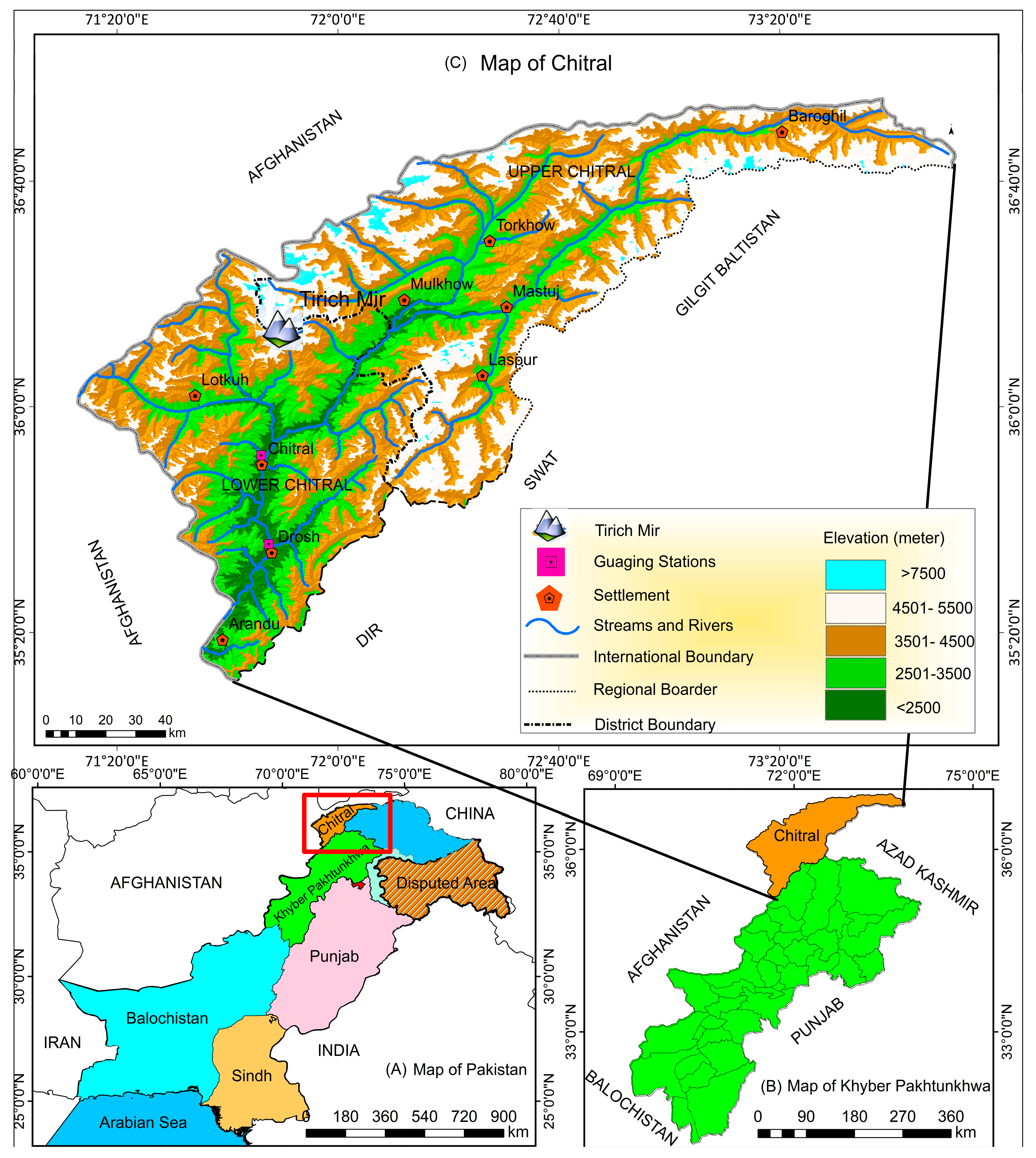

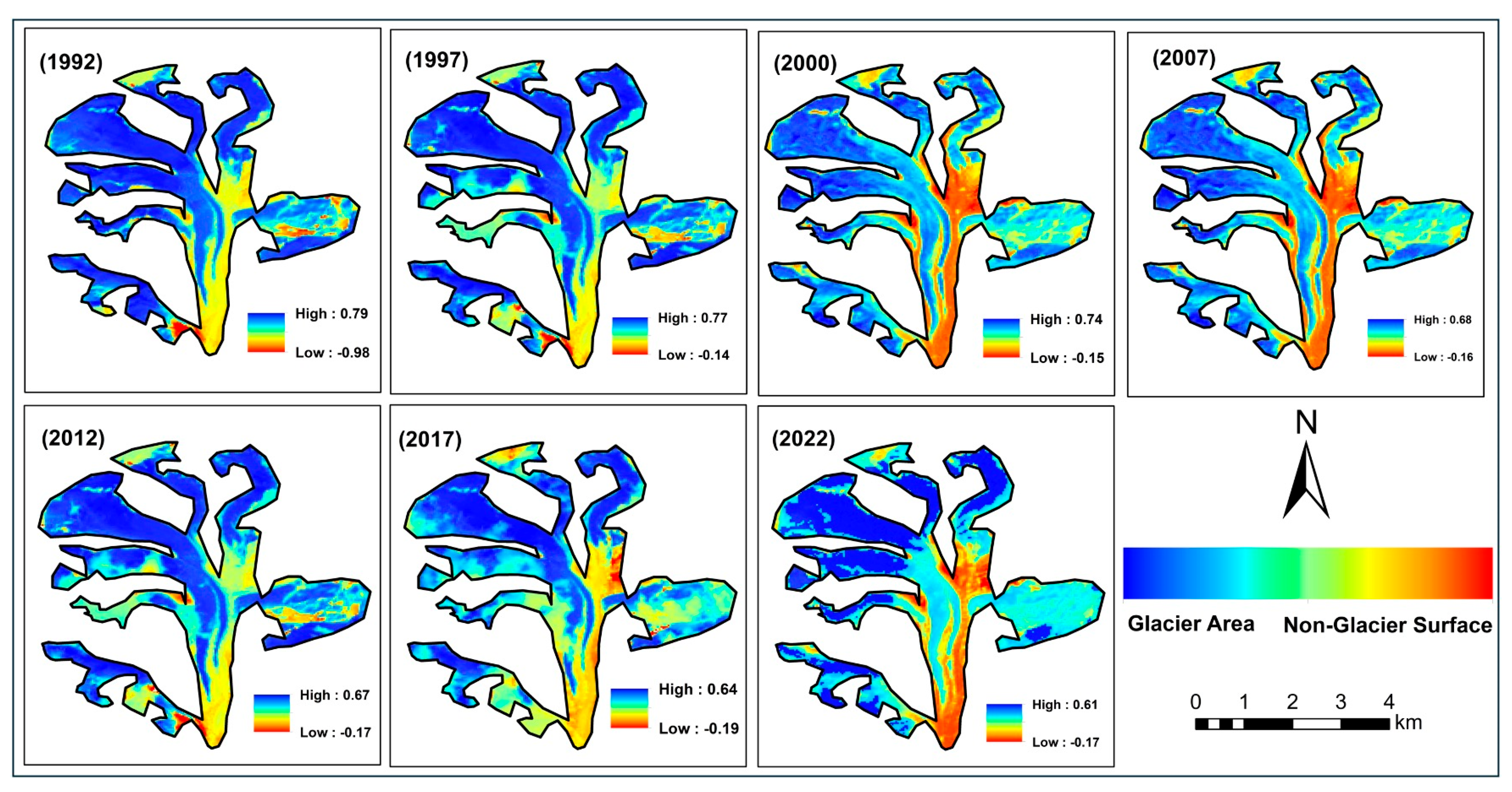


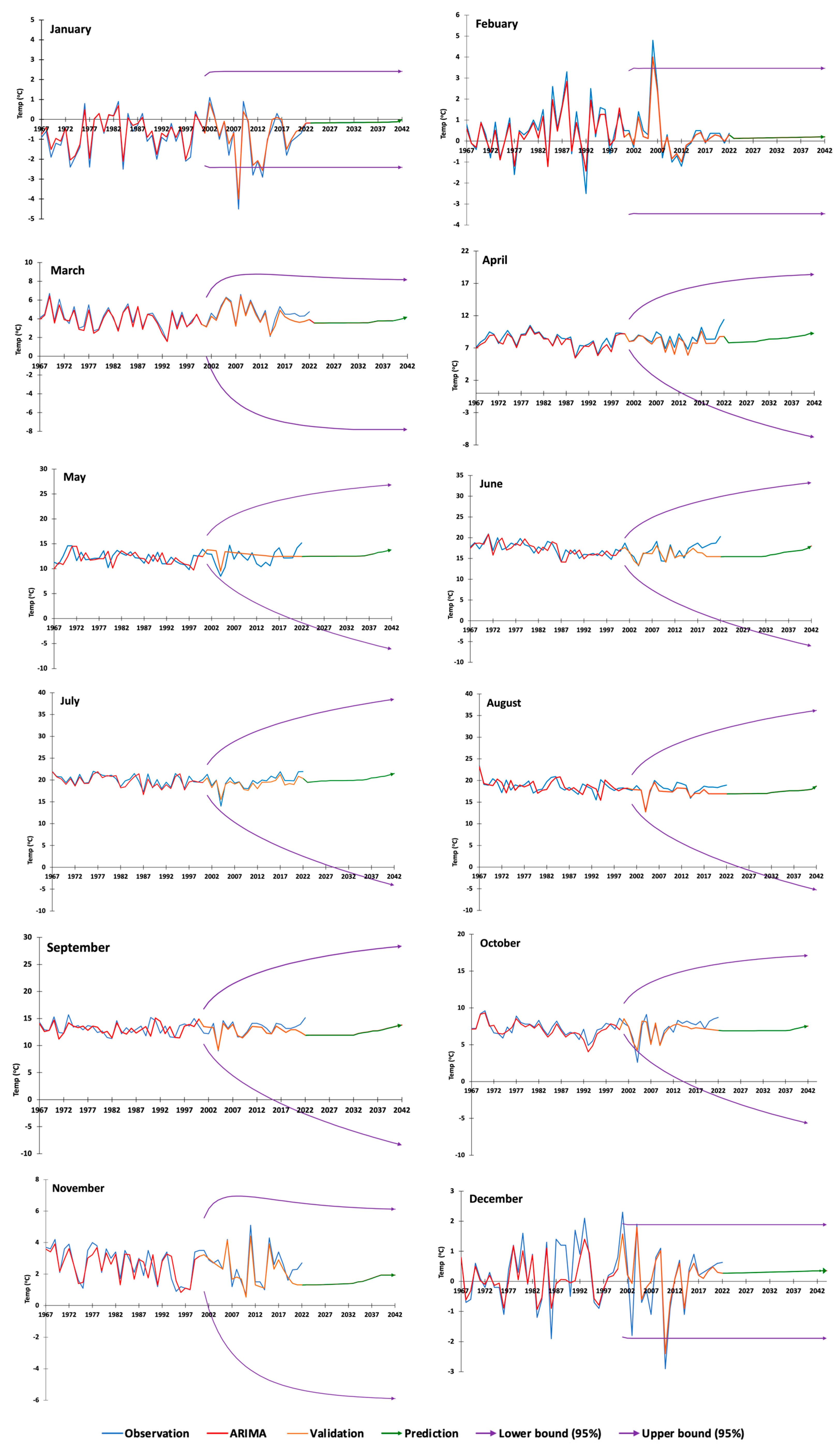
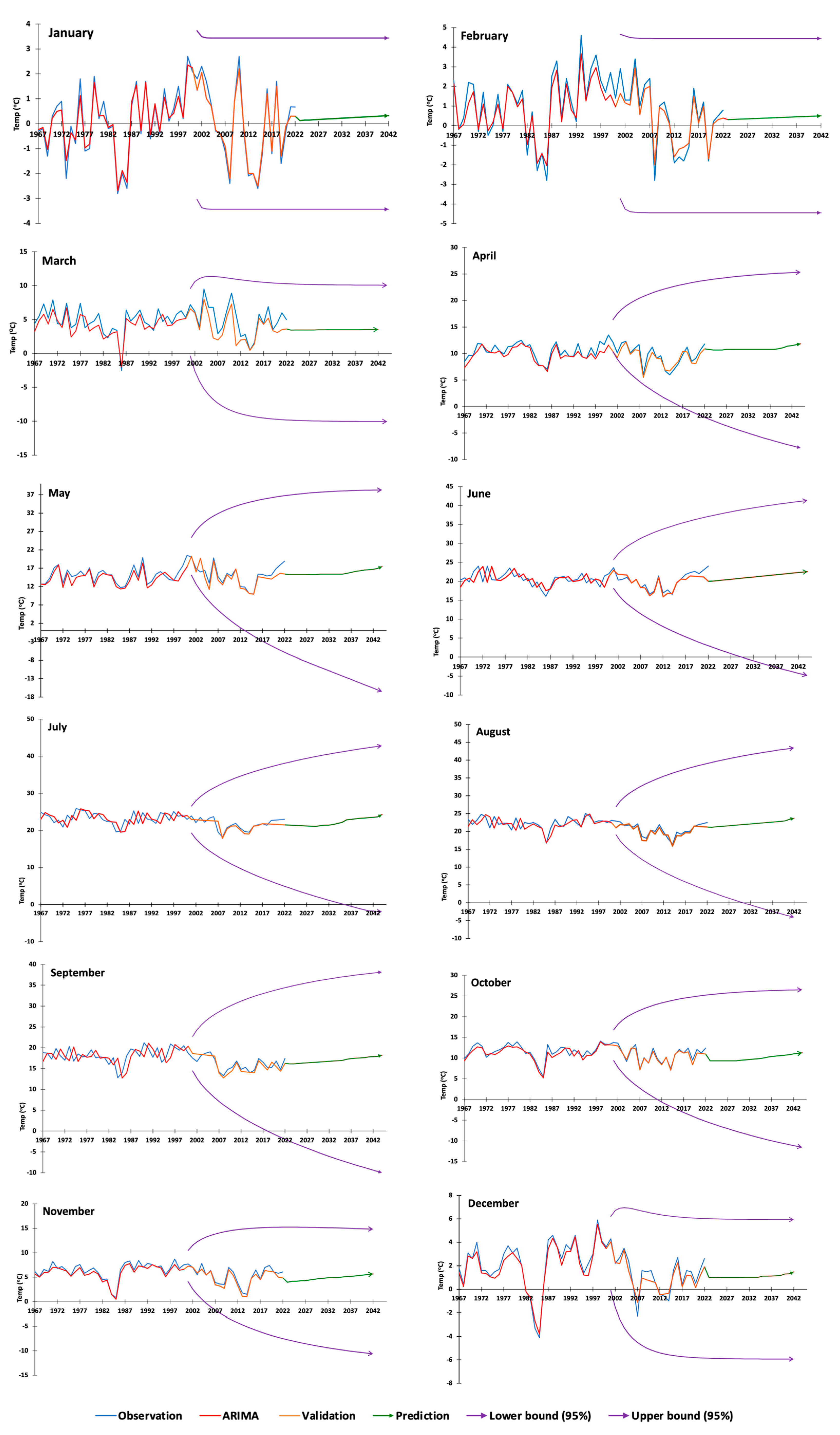
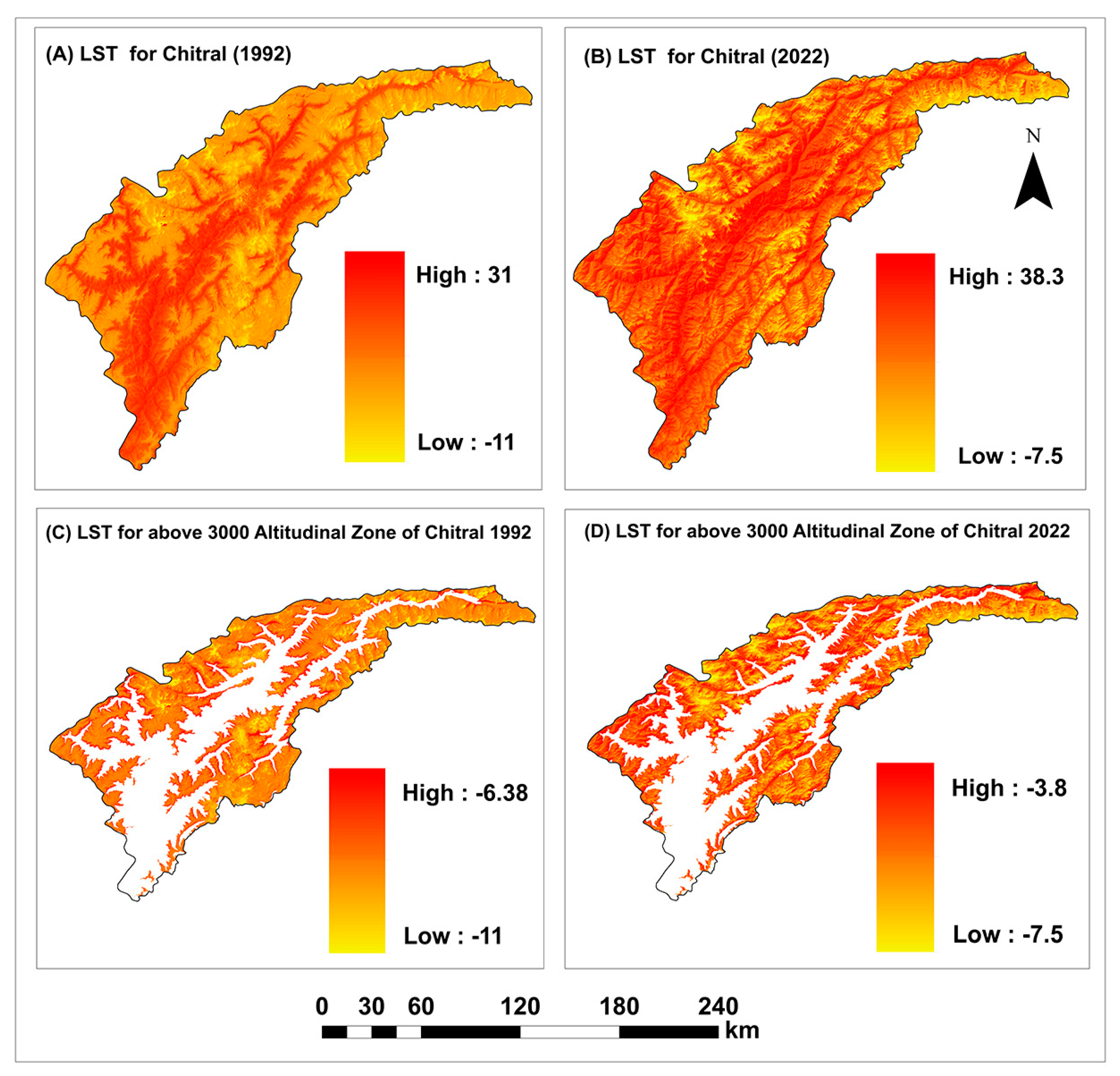


| Acquisition Date | Dataset | Sensor | ID | Spatial Resolution | Cloud Cover | |
|---|---|---|---|---|---|---|
| Row | Path | |||||
| 31 August 1992 | LT05 | TM | 150, 151 | 034, 035, 036 | 30 m | <10% |
| 16 July 1997 | LT05 | TM | 150, 151 | 034, 035, 036 | 30 m | <10% |
| 30 August 2002 | LT05 | TM | 150, 151 | 034, 035, 036 | 30 m | <10% |
| 17 July 2007 | LE05 | TM | 150, 151 | 034, 035, 036 | 30 m | <10% |
| 8 July 2012 | LE05 | TM | 150, 151 | 034, 035, 036 | 30 m | <10% |
| 15 August 2017 | LC08 | OLI | 150, 151 | 034, 035, 036 | 30 m | <10% |
| 23 September 2022 | LC08 | OLI | 150, 151 | 034, 035, 036 | 30 m | <10% |
| 8 July 2022 | Sentinel-2A | MSI | T42SXE | A035981 | 10 m | <10% |
| Year | Overall Accuracy (%) | User’s Accuracy (%) | Producer’s Accuracy (%) | Commission Error (%) | Omission Error (%) | Kappa Coefficient (%) |
|---|---|---|---|---|---|---|
| 1992 | 86.7 | 83.9 | 79.4 | 22.4 | 12.5 | 0.84 |
| 1997 | 89.5 | 86.1 | 82.1 | 16.7 | 10.4 | 0.87 |
| 2002 | 91.7 | 89.8 | 80.6 | 18.5 | 13.7 | 0.89 |
| 2007 | 93.5 | 91.4 | 86.2 | 24.6 | 18.2 | 0.91 |
| 2012 | 92.8 | 80.4 | 86.7 | 14.9 | 10.6 | 0.88 |
| 2017 | 87.5 | 91.1 | 89.1 | 20.3 | 15.7 | 0.92 |
| 2022 | 94.7 | 89.7 | 87.7 | 17.2 | 9.8 | 0.95 |
| Year | Area (km2) | Change (km2) | Change (%) | Average Annual Change (km2) |
|---|---|---|---|---|
| 1992 | 2650 | --- | --- | --- |
| 1997 | 2600 | −50 | −1.9 | −10.0 |
| 2002 | 2501 | −99 | −3.8 | −19.8 |
| 2007 | 2462 | −39 | −1.6 | −7.8 |
| 2012 | 2236 | −226 | −9.2 | −45.2 |
| 2017 | 2009 | −227 | −10.2 | −45.4 |
| 2022 | 1834 | −175 | −8.7 | −35.0 |
| 1992–2022 | --- | −816 | −30.8 | −27.2 |
| Year | Area (km2) | Change (km2) | Change (%) | Average Annual Change (km2) |
|---|---|---|---|---|
| 1992 | 9.66 | --- | --- | --- |
| 1997 | 9.50 | −0.16 | −1.7 | −0.03 |
| 2002 | 7.52 | −1.98 | −20.8 | −0.40 |
| 2007 | 7.30 | −0.22 | −2.9 | −0.04 |
| 2012 | 7.00 | −0.30 | −4.1 | −0.06 |
| 2017 | 6.73 | −0.27 | −3.9 | −0.05 |
| 2022 | 6.41 | −0.32 | −4.8 | −0.06 |
| 1992–2022 | --- | −3.25 | −33.6 | −0.67 |
| Month | Chitral City | Drosh | ||||||||||
|---|---|---|---|---|---|---|---|---|---|---|---|---|
| Kendall’s Tau (τ) | S′ (S Prime) | Var (S′) | p | TSS | Ho | Kendall’s Tau (τ) | S′ (S Prime) | Var (S′) | p | TSS | Ho | |
| Jan | 0.32 | 23 | 149 | 0.043 | 0.75 | Rejected | 0.06 | 4 | 104 | 0.036 | 0.48 | Rejected |
| Feb | 0.21 | 15 | 144 | 0.021 | 0.64 | Rejected | 0.06 | 4 | 104 | 0.769 | 0.29 | Accepted |
| Mar | 0.33 | 24 | 155 | 0.541 | 0.55 | Accepted | 0.10 | 7 | 103 | 0.554 | 0.42 | Accepted |
| Apr | 0.31 | 22 | 146 | 0.049 | 0.50 | Rejected | 0.08 | 6 | 102 | 0.621 | 0.05 | Accepted |
| May | 0.21 | 15 | 93 | 0.119 | 0.54 | Accepted | 0.13 | 9 | 103 | 0.043 | 0.41 | Rejected |
| Jun | 0.03 | 2 | 106 | 0.015 | 0.01 | Rejected | 0.14 | 10 | 102 | 0.042 | 0.02 | Rejected |
| Jul | 0.14 | 10 | 126 | 0.043 | 0.46 | Rejected | 0.04 | 3 | 101 | 0.032 | 0.30 | Rejected |
| Aug | 0.03 | 2 | 148 | 0.052 | 0.30 | Rejected | 0.04 | 3 | 103 | 0.034 | 0.34 | Rejected |
| Sep | 0.03 | 2. | 59 | 0.045 | 0.10 | Rejected | 0.23 | 16 | 102 | 0.037 | 0.20 | Rejected |
| Oct | 0.24 | 17 | 145 | 0.048 | 0.30 | Rejected | −0.06 | −4 | 104 | 0.769 | −0.05 | Accepted |
| Nov | 0.18 | 13 | 113 | 0.021 | 0.24 | Rejected | −0.06 | −4 | 97 | 0.761 | −0.25 | Accepted |
| Dec | 0.20 | 14 | 162 | 0.027 | 0.45 | Rejected | 0.07 | 5 | 103 | 0.039 | 0.17 | Rejected |
| Month | Chitral city | Drosh | ||||||||||
|---|---|---|---|---|---|---|---|---|---|---|---|---|
| Kendall’s Tau (τ) | S′ (S Prime) | Var (S′) | p | TSS | Ho | Kendall’s Tau (τ) | S′ (S Prime) | Var (S′) | p | TSS | Ho | |
| Jan | 0.12 | −9 | 103 | 0.037 | 0.14 | Rejected | 0.06 | 4 | 104 | 0.025 | 0.01 | Rejected |
| Feb | 0.03 | 2 | 102 | 0.025 | 0.02 | Rejected | 0.08 | 2 | 104 | 0.413 | −0.01 | Accepted |
| Mar | 0.20 | 14 | 102 | 0.203 | 0.10 | Accepted | −0.07 | −1 | 103 | 0.437 | −0.01 | Accepted |
| Apr | 0.11 | 8 | 102 | 0.492 | −0.22 | Accepted | 0.20 | 16 | 104 | 0.014 | 0.03 | Rejected |
| May | 0.22 | 16 | 104 | 0.014 | −0.57 | Rejected | 0.08 | 5 | 103 | 0.026 | 0.02 | Rejected |
| Jun | 0.54 | 38 | 102 | 0.017 | 1.07 | Rejected | 0.29 | 20 | 102 | 0.001 | 0.06 | Rejected |
| Jul | 0.39 | 28 | 104 | 0.012 | 0.44 | Rejected | 0.38 | 26 | 104 | 0.0001 | 0.06 | Rejected |
| Aug | 0.35 | 25 | 103 | 0.024 | 0.16 | Rejected | 0.40 | 27 | 103 | 0.0001 | 0.06 | Rejected |
| Sep | 0.01 | 1 | 103 | 0.017 | 0.02 | Rejected | 0.33 | 15 | 103 | 0.001 | 0.07 | Rejected |
| Oct | 0.13 | 9 | 103 | 0.430 | 0.04 | Accepted | 0.22 | 13 | 103 | 0.024 | 0.04 | Rejected |
| Nov | 0.40 | 28 | 100 | 0.012 | −0.53 | Rejected | 0.21 | 5 | 103 | 0.028 | 0.04 | Rejected |
| Dec | 0.11 | 8 | 104 | 0.049 | 0.10 | Rejected | 0.12 | 7 | 101 | 0.034 | 0.02 | Rejected |
| Month | Chitral city | Drosh | ||||||||||
|---|---|---|---|---|---|---|---|---|---|---|---|---|
| Kendall’s tau (τ) | S′ (S Prime) | Var (S′) | p | TSS | Ho | Kendall’s tau (τ) | S′ (S Prime) | Var (S′) | p | TSS | Ho | |
| Jan | −0.57 | −4.0 | 104 | 0.017 | −2.68 | Rejected | −0.46 | −4 | 104 | 0.007 | −7.26 | Rejected |
| Feb | −0.17 | −12.0 | 104 | 0.028 | −8.29 | Rejected | −0.62 | −16 | 104 | 0.014 | −8.48 | Rejected |
| Mar | −0.03 | −2.0 | 104 | 0.032 | −4.72 | Rejected | −0.06 | −4 | 104 | 0.037 | −3.30 | Rejected |
| Apr | −0.06 | −4.0 | 104 | 0.769 | 0.81 | Accepted | −0.25 | −18 | 104 | 0.102 | −9.92 | Accepted |
| May | 0.06 | 4.0 | 104 | 0.769 | 4.33 | Accepted | −0.08 | −6 | 104 | 0.624 | −5.63 | Accepted |
| Jun | 0.15 | 11.0 | 103 | 0.324 | −0.16 | Accepted | 0.24 | 17 | 103 | 0.110 | 4.50 | Accepted |
| Jul | 0.22 | −16.0 | 104 | 0.141 | −1.22 | Accepted | 0.08 | −6 | 104 | 0.104 | −2.90 | Accepted |
| Aug | 0.01 | 1.0 | 103 | 0.154 | −1.03 | Accepted | 0.08 | 6 | 104 | 0.620 | 0.31 | Accepted |
| Sep | 0.36 | 26.0 | 104 | 0.014 | 1.97 | Rejected | −0.01 | −1 | 103 | 1.001 | 0.32 | Accepted |
| Oct | 0.08 | 6.0 | 104 | 0.624 | 1.66 | Accepted | −0.11 | −8 | 104 | 0.490 | −2.27 | Accepted |
| Nov | 0.22 | 16.0 | 104 | 0.141 | 6.29 | Accepted | 0.19 | 14 | 104 | 0.200 | 4.82 | Accepted |
| Dec | −0.76 | −4.0 | 104 | 0.039 | −1.28 | Rejected | −0.25 | −18 | 104 | 0.001 | −10.58 | Rejected |
Disclaimer/Publisher’s Note: The statements, opinions and data contained in all publications are solely those of the individual author(s) and contributor(s) and not of MDPI and/or the editor(s). MDPI and/or the editor(s) disclaim responsibility for any injury to people or property resulting from any ideas, methods, instructions or products referred to in the content. |
© 2025 by the authors. Licensee MDPI, Basel, Switzerland. This article is an open access article distributed under the terms and conditions of the Creative Commons Attribution (CC BY) license (https://creativecommons.org/licenses/by/4.0/).
Share and Cite
Ahmad, Z.; Altaf, F.; Kamp, U.; Rahman, F.; Malik, S.M. Glacier Recession and Climate Change in Chitral, Eastern Hindu Kush Mountains of Pakistan, Between 1992 and 2022. Geosciences 2025, 15, 167. https://doi.org/10.3390/geosciences15050167
Ahmad Z, Altaf F, Kamp U, Rahman F, Malik SM. Glacier Recession and Climate Change in Chitral, Eastern Hindu Kush Mountains of Pakistan, Between 1992 and 2022. Geosciences. 2025; 15(5):167. https://doi.org/10.3390/geosciences15050167
Chicago/Turabian StyleAhmad, Zahir, Farhana Altaf, Ulrich Kamp, Fazlur Rahman, and Sher Muhammad Malik. 2025. "Glacier Recession and Climate Change in Chitral, Eastern Hindu Kush Mountains of Pakistan, Between 1992 and 2022" Geosciences 15, no. 5: 167. https://doi.org/10.3390/geosciences15050167
APA StyleAhmad, Z., Altaf, F., Kamp, U., Rahman, F., & Malik, S. M. (2025). Glacier Recession and Climate Change in Chitral, Eastern Hindu Kush Mountains of Pakistan, Between 1992 and 2022. Geosciences, 15(5), 167. https://doi.org/10.3390/geosciences15050167







